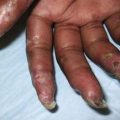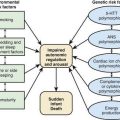Chapter 484 Lymphadenopathy
Diagnosis
Is the lymphadenopathy localized or generalized? Generalized adenopathy (enlargement of >2 noncontiguous node regions) is caused by systemic disease (Table 484-1) and is often accompanied by abnormal physical findings in other systems. In contrast, regional adenopathy is most frequently the result of infection in the involved node and/or its drainage area (Table 484-2). When due to infectious agents other than bacteria, adenopathy may be characterized by atypical anatomic areas, a prolonged course, a draining sinus, lack of prior pyogenic infection, and unusual clues in the history (cat scratches, tuberculosis exposure, venereal disease). A firm, fixed node should always raise the question of malignancy, regardless of the presence or absence of systemic symptoms or other abnormal physical findings.
Table 484-1 DIFFERENTIAL DIAGNOSIS OF SYSTEMIC GENERALIZED LYMPHADENOPATHY
| INFANT | CHILD | ADOLESCENT |
|---|---|---|
| COMMON CAUSES | ||
| Syphilis | Viral infection | Viral infection |
| Toxoplasmosis | EBV | EBV |
| CMV | CMV | CMV |
| HIV | HIV | HIV |
| Toxoplasmosis | Toxoplasmosis | |
| Syphilis | ||
| RARE CAUSES | ||
| Chagas disease (congenital) | Serum sickness | Serum sickness |
| Congenital leukemia | SLE, JRA | SLE, JRA |
| Congenital tuberculosis | Leukemia/lymphoma | Leukemia/lymphoma/Hodgkin disease |
| Reticuloendotheliosis | Tuberculosis | Lymphoproliferative disease |
| Lymphoproliferative disease | Measles | Tuberculosis |
| Metabolic storage disease | Sarcoidosis | Histoplasmosis |
| Histiocytic disorders | Fungal infection | Sarcoidosis |
| Plague | Fungal infection | |
| Langerhans cell histiocytosis | Plague | |
| Chronic granulomatous disease | Drug reaction | |
| Sinus histiocytosis | Castleman disease | |
| Drug reaction | ||
CMV, cytomegalovirus; EBV, Epstein-Barr virus; HIV, human immunodeficiency virus; JRA, juvenile rheumatoid arthritis (Still disease); SLE, systemic lupus erythematosus.
From Kliegman RM, Greenbaum LA, Lye PS: Practical strategies in pediatric diagnosis and therapy, ed 2, Philadelphia, 2004, Elsevier, p 863.
Table 484-2 SITES OF LOCAL LYMPHADENOPATHY AND ASSOCIATED DISEASES
CERVICAL
ANTERIOR AURICULAR
SUPRACLAVICULAR
EPITROCHLEAR
INGUINAL
HILAR (NOT PALPABLE, FOUND ON CHEST RADIOGRAPH OR CT)
AXILLARY
ABDOMINAL
CMV, cytomegalovirus; CT, computed tomography; EBV, Epstein-Barr virus; HHV-6, human herpesvirus 6.
From Kliegman RM, Greenbaum LA, Lye PS: Practical strategies in pediatric diagnosis and therapy, ed 2, Philadelphia, 2004, Elsevier, p 864.
484.1 Kikuchi-Fujimoto Disease (Histiocytic Necrotizing Lymphadenitis)
Chuang CH, Yan DC, Chiu CH, et al. Clinical and laboratory manifestations of Kikuchi’s disease in children and differences between patients with and without prolonged fever. Pediatr Infect Dis J. 2005;24:551-554.
Hudnall SD, Chen T, Amr S, et al. Detection of human herpesvirus DNA in Kikuchi-Fujimoto disease and reactive lymphoid hyperplasia. Int J Clin Exp Pathol. 2008;1:362-368.
Ifeacho S, Aung T, Akinsola M. Kikuchi-Fujimoto disease: a case report and review of the literature. Cases J. 2008;1:187.
Jun-Fen F, Chun-Lin W, Li L, et al. Kikuchi-Fujimoto disease manifesting as recurrent thrombocytopenia and Mobitz type II atrioventricular block in a 7-year-old girl: a case report and analysis of 138 Chinese childhood Kikuchi-Fujimoto cases with 10 years of follow-up in 97 patients. Acta Paediatr. 2007;96:1844-1847.
Kalambokis G, Economou G, Nikas S, et al. Concurrent development of spontaneous pyomyositis due to Staphylococcus epidermidis and Kikuchi-Fujimoto disease. Intern Med. 2008;47:2139-2143.
Lazzareschi I, Barone G, Ruggiero A, et al. Paediatric Kikuchi-Fujimoto disease: a benign cause of fever and lymphadenopathy. Pediatr Blood Cancer. 2008;50:119-123.
Scagni P, Peisino MG, Bianchi M, et al. Kikuchi-Fujimoto disease is a rare cause of lymphadenopathy and fever of unknown origin in children: report of two cases and review of the literature. J Pediatr Hematol Oncol. 2005;27:337-340.
Wong VK, Campion-Smith J, Khan M, et al. Kikuchi disease in association with Pasteurella multocida infection. Pediatrics. 2010;125:e679-e682.
484.2 Sinus Histiocytosis with Massive Lymphadenopathy (Rosai-Dorfman Disease)
Carbone A, Passannante A, Gloghini A, et al. Review of sinus histiocytosis with massive lymphadenopathy (Rosai-Dorfman disease) of head and neck. Ann Otol Rhinol Laryngol. 1999;108:1095-1104.
McClain KL, Natkunam Y, Swerdlow SH. Atypical cellular disorders. Am Soc Hematol Educ Program. 2004:283-296.
Pulsoni A, Anghel G, Falcucci P, et al. Treatment of sinus histiocytosis with massive lymphadenopathy (Rosai-Dorfman disease): report of a case and literature review. Am J Hematol. 2002;69:67-71.
Raveenthiran V, Dhanalakshmi M, Hayavadana Rao PV, et al. Rosai-Dorfman disease: report of a 3-year-old girl with critical review of treatment options. Eur J Pediatr Surg. 2003;13:350-354.
Utikal J, Ugurel S, Kurzen H, et al. Imatinib as a treatment option for systemic non-Langerhans cell histiocytoses. Arch Dermatol. 2007;143:736-740.
Weitzman S, Jaffe R. Uncommon histiocytic disorders: the non-Langerhans cell histiocytoses. Pediatr Blood Cancer. 2005;45:256-264.
484.3 Castleman Disease
Bower M, Powles T, Williams S, et al. Brief communication: rituximab in HIV-associated multicentric Castleman disease. Ann Intern Med. 2007;147:836-839.
Casper C. The aetiology and management of Castleman disease at 50 years: translating pathophysiology to patient care. Br J Haematol. 2005;129:3-17.
Casper C. New approaches to the treatment of human herpesvirus 8-associated disease. Rev Med Virol. 2008;18:321-329.
Dham A, Peterson BA. Castleman disease. Curr Opin Hematol. 2007;14:354-359.
Dispenzieri A, Gertz MA. Treatment of Castleman’s disease. Curr Treat Options Oncol. 2005;6:255-266.
Nishimoto N. Clinical studies in patients with Castleman’s disease, Crohn’s disease, and rheumatoid arthritis in Japan. Clin Rev Allergy Immunol. 2005;28:221-229.
Stebbing J, Pantanowitz L, Dayyani F, et al. HIV-associated multicentric Castleman’s disease. Am J Hematol. 2008;83:498-503.
Albright JT, Pransky SM. Nontuberculous mycobacterial infections of the head and neck. Pediatr Clin North Am. 2003;50:503-514.
Choi P, Qun X, Chen EY, et al. Polymerase chain reaction for pathogen identification in persistent pediatric cervical lymphadenitis. Arch Otolaryngol Head Neck Surg. 2009;135:243-248.
Friedmann AM. Evaluation and management of lymphadenopathy in children. Pediatr Rev. 2008;29:53-60.
Nield LS, Kamat D. Lymphadenopathy in children: when and how to evaluate. Clin Pediatr (Phila). 2004;43:25-33.
Restrepo R, Oneto J, Lopez K, et al. Head and neck lymph nodes in children: the spectrum from normal to abnormal. Pediatr Radiol. 2009;39:836-846.
Tokuda Y, Kishaba Y, Kato J, et al. Assessing the validity of a model to identify patients for lymph node biopsy. Medicine. 2003;82:414-418.
Twist CJ, Link MP. Assessment of lymphadenopathy in children. Pediatr Clin North Am. 2002;49:1009-1025.







